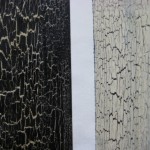Supplies needed:
- Titebond Hide Glue www.titebond.com, or Behlen Ground Hide Glue www.stewmac.com
- Fabric (cotton, canvas) or paper: non-woven Tyvek, Lutradur, Yupo
- Acrylic paints in two colors: preferably one dark, one light.
- Brush or roller to apply paint and glue with
This technique is most commonly used by woodworkers. The glues can be purchased at stores that cater to fine woodworking or on the internet.
This is a 3 step process:
- Paint fabric with one color of paint (If you are using canvas, you may want to first apply a coat of gesso.) Let paint dry.
- Cover with a coating of hide glue. For large cracks, use full strength. For smaller cracks, dilute with water. Let dry. Drying time will vary, but usually takes about an hour, depending on the size of the area covered.
- Apply a second coat of paint; magically, the cracking will appear. Let dry thoroughly. I like to coat the top with an acrylic sealer.
There is no real way to control the crackle. Other ways to apply the glue include: foam stamp, stencil, silk screen. The glue will act as a resist. Remember to keep good notes and experiment.
Questions
What is hide glue? In a nutshell, it is the hide and bone renderings of an animal (usually horse or cow) that has been sent to the rendering plant. Also known as the glue factory. While hide glue does have an odor, it will disappear in a few days.
What is hide glue used for? Glueing wood together and crackling techniques.

